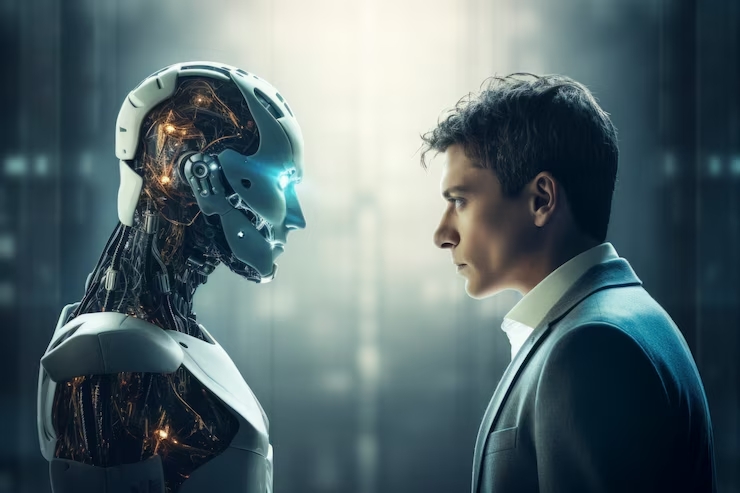Artificial Intelligence (AI) has evolved dramatically over the past decade—from cold, machine-driven systems to tools that increasingly understand, support, and even empathize with human needs. Today, we’re entering a new phase: human-centric AI, a powerful shift where machines are designed not just to perform tasks but to adapt meaningfully to people’s behaviors, emotions, and goals.
In this article, we explore how human-centric AI is changing the digital landscape, enhancing daily life, and shaping the future of human-machine interaction.
What Is Human-Centric AI?
Human-centric AI is an approach that places people at the center of artificial intelligence design and deployment. Unlike traditional AI models that prioritize efficiency, data collection, or prediction accuracy alone, human-centric systems aim to be:
-
Ethical
-
Transparent
-
Empathetic
-
Personalized
This means creating systems that can not only process complex information but also understand human context—our language, tone, body language, preferences, and emotions.
Everyday Examples: AI That Feels More Human
We’re already seeing this shift in tools we use every day:
-
Virtual assistants like Siri, Alexa, and Google Assistant are becoming more conversational and context-aware.
-
AI in healthcare is helping doctors deliver more personalized treatment plans by learning individual patient histories.
-
Smart devices are now capable of adjusting lighting, sound, or screen time based on a user’s mood or routine.
-
Customer support chatbots are trained to respond empathetically and understand frustration or satisfaction.
These improvements may seem small, but they’re the foundation of deeper, more intelligent relationships between humans and machines.
Why Human-Centric AI Matters
This evolution isn’t just about convenience. It’s about trust and usability. For AI to work at its full potential, it needs human cooperation—and that can only happen if people trust the system.
Human-centric AI helps bridge the gap between advanced algorithms and real-world usefulness by:
-
Improving adoption: People are more likely to use technology that feels intuitive and respectful.
-
Reducing bias: Ethical design frameworks can help prevent harmful outcomes by ensuring the AI serves diverse populations fairly.
-
Enhancing mental health and well-being: Emotional AI can support wellness apps, therapy bots, and mood tracking tools in non-intrusive ways.
-
Protecting autonomy: Human-focused design gives users more control and transparency over how their data is used.
In essence, it makes AI feel less like a tool, and more like a companion that understands your rhythm.
The Role of Personalization
One of the key drivers of human-centric AI is hyper-personalization. By learning user behavior and feedback, systems can offer experiences tailored to individual needs:
-
Streaming platforms recommend content based on subtle user signals.
-
E-commerce websites create dynamic product pages based on browsing history and interaction.
-
Language learning apps adjust exercises based on how fast you learn or which topics challenge you the most.
This level of personalization can increase user satisfaction and engagement, making technology feel more helpful than ever before.
The Ethical Challenge
Of course, humanizing AI raises important ethical questions:
-
How much should AI know about us?
-
Who controls how this information is used?
-
Can we ensure algorithms don’t reinforce harmful stereotypes or bias?
Answering these questions requires not only technical innovation but also social responsibility. Transparency in how AI decisions are made, clear user consent, and strong privacy protections are all non-negotiable parts of this new era.
Many organizations are now including ethicists, sociologists, and human rights experts in AI development teams to make sure the technology aligns with public good—not just profit.
Future Outlook: Where Are We Headed?
Looking ahead, human-centric AI will only grow more advanced. In the near future, we can expect:
-
Emotion-aware AI that recognizes tone, facial expressions, or stress levels to adapt its response.
-
AI coaches for personal development, helping you stay on track with your goals or offering encouragement in tough times.
-
Collaborative creativity tools that work side by side with humans in writing, design, and music.
-
Accessible technology for people with disabilities that adapts interfaces based on unique needs.
Eventually, we may no longer need to adapt ourselves to machines—they will adapt to us.
Final Thoughts
Human-centric AI isn’t about making machines more human—it’s about making technology more humane. As artificial intelligence becomes part of everything from our smartphones to our homes and workplaces, it’s essential that these systems are designed with empathy, ethics, and everyday usability in mind.
By focusing on human needs, values, and experiences, we’re not just building smarter systems—we’re building a smarter future.




